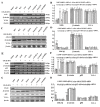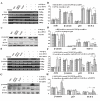Axin downregulates TCF-4 transcription via beta-catenin, but not p53, and inhibits the proliferation and invasion of lung cancer cells
- PMID: 20122174
- PMCID: PMC2827467
- DOI: 10.1186/1476-4598-9-25
Axin downregulates TCF-4 transcription via beta-catenin, but not p53, and inhibits the proliferation and invasion of lung cancer cells
Abstract
Background: We previously reported that overexpression of Axin downregulates T cell factor-4 (TCF-4) transcription. However, the mechanism(s) by which Axin downregulates the transcription and expression of TCF-4 is not clear. It has been reported that beta-catenin promotes and p53 inhibits TCF-4 transcription, respectively. The aim of this study was to investigate whether beta-catenin and/or p53 is required for Axin-mediated downregulation of TCF-4.
Results: Axin mutants that lack p53/HIPK2 and/or beta-catenin binding domains were expressed in lung cancer cells, BE1 (mutant p53) and A549 (wild type p53). Expression of Axin or AxinDeltap53 downregulates beta-catenin and TCF-4, and knock-down of beta-catenin upregulates TCF-4 in BE1 cells. However, expression of AxinDeltabeta-ca into BE1 cells did not downregulate TCF-4 expression. These results indicate that Axin downregulates TCF-4 transcription via beta-catenin. Although overexpression of wild-type p53 also downregulates TCF-4 in BE1 cells, cotransfection of p53 and AxinDeltabeta-ca did not downregulate TCF-4 further. These results suggest that Axin does not promote p53-mediated downregulation of TCF-4. Axin, AxinDeltap53, and AxinDeltabeta-ca all downregulated beta-catenin and TCF-4 in A549 cells. Knock-down of p53 upregulated beta-catenin and TCF-4, but cotransfection of AxinDeltabeta-ca and p53 siRNA resulted in downregulation of beta-catenin and TCF-4. These results indicate that p53 is not required for Axin-mediated downregulation of TCF-4. Knock-down or inhibition of GSK-3beta prevented Axin-mediated downregulation of TCF-4. Furthermore, expression of Axin and AxinDeltap53, prevented the proliferative and invasive ability of BE1 and A549, expression of AxinDeltabeta-ca could only prevented the proliferative and invasive ability effectively.
Conclusions: Axin downregulates TCF-4 transcription via beta-catenin and independently of p53. Axin may also inhibits the proliferation and invasion of lung cancer cells via beta-catenin and p53.
Figures










Similar articles
-
Overexpression of axin downregulates TCF-4 and inhibits the development of lung cancer.Ann Surg Oncol. 2007 Nov;14(11):3251-9. doi: 10.1245/s10434-007-9555-9. Epub 2007 Sep 1. Ann Surg Oncol. 2007. PMID: 17768662 Clinical Trial.
-
Modulation of beta-catenin-mediated TCF-signalling in prostate cancer cell lines by wild-type and mutant p53.Prostate. 2007 Dec 1;67(16):1751-60. doi: 10.1002/pros.20660. Prostate. 2007. PMID: 17929268
-
Downregulation of beta-catenin by p53 involves changes in the rate of beta-catenin phosphorylation and Axin dynamics.Oncogene. 2004 May 27;23(25):4444-53. doi: 10.1038/sj.onc.1207587. Oncogene. 2004. PMID: 15064706
-
Zbed3 promotes proliferation and invasion of lung cancer partly through regulating the function of Axin-Gsk3β complex.J Cell Mol Med. 2019 Feb;23(2):1014-1021. doi: 10.1111/jcmm.14001. Epub 2018 Nov 12. J Cell Mol Med. 2019. PMID: 30417576 Free PMC article.
-
Calcium, calcium-sensing receptor and colon cancer.Cancer Lett. 2009 Mar 8;275(1):9-16. doi: 10.1016/j.canlet.2008.07.001. Epub 2008 Aug 23. Cancer Lett. 2009. PMID: 18725175 Review.
Cited by
-
A review of therapeutic potentials of milk thistle (Silybum marianum L.) and its main constituent, silymarin, on cancer, and their related patents.Iran J Basic Med Sci. 2022 Oct;25(10):1166-1176. doi: 10.22038/IJBMS.2022.63200.13961. Iran J Basic Med Sci. 2022. PMID: 36311193 Free PMC article. Review.
-
Simultaneous overactivation of Wnt/β-catenin and TGFβ signalling by miR-128-3p confers chemoresistance-associated metastasis in NSCLC.Nat Commun. 2017 Jun 19;8:15870. doi: 10.1038/ncomms15870. Nat Commun. 2017. PMID: 28627514 Free PMC article.
-
Hepatic circadian and differentiation factors control liver susceptibility for fatty liver disease and tumorigenesis.FASEB J. 2022 Sep;36(9):e22482. doi: 10.1096/fj.202101398R. FASEB J. 2022. PMID: 35947136 Free PMC article.
-
Additional Inhibition of Wnt/β-Catenin Signaling by Metformin in DAA Treatments as a Novel Therapeutic Strategy for HCV-Infected Patients.Cells. 2021 Apr 2;10(4):790. doi: 10.3390/cells10040790. Cells. 2021. PMID: 33918222 Free PMC article.
-
Targeting ER stress/PKA/GSK-3β/β-catenin pathway as a potential novel strategy for hepatitis C virus-infected patients.Cell Commun Signal. 2023 May 8;21(1):102. doi: 10.1186/s12964-023-01081-9. Cell Commun Signal. 2023. PMID: 37158967 Free PMC article.
References
-
- Lustig B, Behrens J. The Wnt signaling pathway and its role in tumor development. J Cancer Res Clin Oncol. 2003;129:199–221. - PubMed
-
- Ueta T, Ikeguchi M, Hirooka Y, Kaibara N, Terada T. Beta-catenin and cyclin D1 expression in human hepatocellular carcinoma. Oncol Rep. 2002;9:1197–1203. - PubMed
-
- Cheng XX, Sun Y, Chen XY, Zhang KL, Kong QY, Liu J, Li H. Frequent translocalization of beta-catenin in gastric cancers and its relevance to tumor progression. Oncol Rep. 2004;11:1201–1207. - PubMed
-
- Xu HT, Wang L, Lin D, Liu Y, Liu N, Yuan XM, Wang EH. Abnormal beta-catenin and reduced axin expression are associated with poor differentiation and progression in non-small cell lung cancer. Am J Clin Pathol. 2006;125:534–541. - PubMed
Publication types
MeSH terms
Substances
LinkOut - more resources
Full Text Sources
Medical
Research Materials
Miscellaneous

